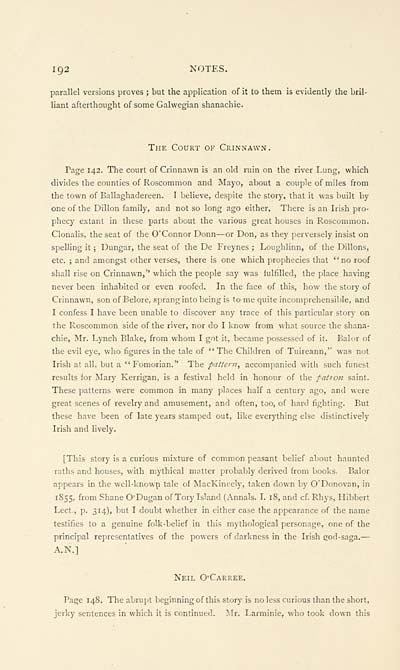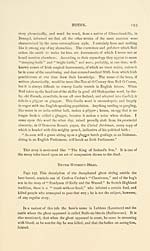Blair Collection > Beside the fire
(254)
Download files
Complete book:
Individual page:
Thumbnail gallery: Grid view | List view

192 NOTES.
parallel versions proves ; but the application of it to them is evidently the bril-
liant afterthought of some Galwegian shanachie.
The Court of Crinnawn.
Page 142. The court of Crinnawn is an old ruin on the river Lung, which
divides the counties of Roscommon and Mayo, about a couple of miles from
the town of Ballaghadereen. I believe, despite the story, that it was built by
one of the Dillon family, and not so long ago either. There is an Irish pro-
phecy extant in these parts about the various great houses in Roscommon.
Clonalis, the seat of the O'Connor Donn — or Don, as they perversely insist on
spelling it ; Dungar, the seat of the De Freynes ; Loughlinn, of the Dillons,
etc. ; and amongst other verses, there is one which prophecies that "no roof
shall rise on Crinnawn," which the people say was fulfilled, the place having
never been inhabited or even roofed. In the face of this, how the story of
Crinnawn, son of Belore, sprang into being is to me quite incomprehensible, and
I confess I have been unable to discover any trace of this particular story on
the Roscommon side of the river, nor do I know from what source the shana-
chie, Mr. Lynch Blake, from whom I got it, became possessed of it. Balor of
the evil eye, who figures in the tale of " The Children of Tuireann," was not
Irish at all, but a "Fomorian." The pattern, accompanied with such funest
results for Mary Kerrigan, is a festival held in honour of the fation saint.
These patterns were common in many places half a century ago, and were
great scenes of revelry and amusement, and often, too, of hard lighting. But
these have been of late years stamped out, like everything else distinctively
Irish and lively.
[This story is a curious mixture of common peasant belief about haunted
raths and houses, with mythical matter probably derived from books. Balor
appears in the well-known tale of MacKineely, taken down by O'Donovan, in
1855, from Shane O'Dugan of Tory Island (Annals. I. 18, and cf. Rhys, Hibbert
Lect., p. 314), but I doubt whether in either case the appearance of the name
testifies to a genuine folk-belief in this mythological personage, one of the
principal representatives of the powers of darkness in the Irish god-saga. —
A.N.]
Neil O'Carree.
Page 148. The abrupt beginning of this story is no less curious than the short,
jerky sentences in which it is continued. Air. Larminie, who took down this
parallel versions proves ; but the application of it to them is evidently the bril-
liant afterthought of some Galwegian shanachie.
The Court of Crinnawn.
Page 142. The court of Crinnawn is an old ruin on the river Lung, which
divides the counties of Roscommon and Mayo, about a couple of miles from
the town of Ballaghadereen. I believe, despite the story, that it was built by
one of the Dillon family, and not so long ago either. There is an Irish pro-
phecy extant in these parts about the various great houses in Roscommon.
Clonalis, the seat of the O'Connor Donn — or Don, as they perversely insist on
spelling it ; Dungar, the seat of the De Freynes ; Loughlinn, of the Dillons,
etc. ; and amongst other verses, there is one which prophecies that "no roof
shall rise on Crinnawn," which the people say was fulfilled, the place having
never been inhabited or even roofed. In the face of this, how the story of
Crinnawn, son of Belore, sprang into being is to me quite incomprehensible, and
I confess I have been unable to discover any trace of this particular story on
the Roscommon side of the river, nor do I know from what source the shana-
chie, Mr. Lynch Blake, from whom I got it, became possessed of it. Balor of
the evil eye, who figures in the tale of " The Children of Tuireann," was not
Irish at all, but a "Fomorian." The pattern, accompanied with such funest
results for Mary Kerrigan, is a festival held in honour of the fation saint.
These patterns were common in many places half a century ago, and were
great scenes of revelry and amusement, and often, too, of hard lighting. But
these have been of late years stamped out, like everything else distinctively
Irish and lively.
[This story is a curious mixture of common peasant belief about haunted
raths and houses, with mythical matter probably derived from books. Balor
appears in the well-known tale of MacKineely, taken down by O'Donovan, in
1855, from Shane O'Dugan of Tory Island (Annals. I. 18, and cf. Rhys, Hibbert
Lect., p. 314), but I doubt whether in either case the appearance of the name
testifies to a genuine folk-belief in this mythological personage, one of the
principal representatives of the powers of darkness in the Irish god-saga. —
A.N.]
Neil O'Carree.
Page 148. The abrupt beginning of this story is no less curious than the short,
jerky sentences in which it is continued. Air. Larminie, who took down this
Set display mode to: Large image | Transcription
Images and transcriptions on this page, including medium image downloads, may be used under the Creative Commons Attribution 4.0 International Licence unless otherwise stated. ![]()
| Early Gaelic Book Collections > Blair Collection > Beside the fire > (254) |
|---|
| Permanent URL | https://digital.nls.uk/76246489 |
|---|
| Description | A collection of Irish Gaelic folk stories. |
|---|---|
| Shelfmark | Blair.222 |
| Additional NLS resources: | |
| Attribution and copyright: |
|
| Description | A selection of books from a collection of more than 500 titles, mostly on religious and literary topics. Also includes some material dealing with other Celtic languages and societies. Collection created towards the end of the 19th century by Lady Evelyn Stewart Murray. |
|---|
| Description | Selected items from five 'Special and Named Printed Collections'. Includes books in Gaelic and other Celtic languages, works about the Gaels, their languages, literature, culture and history. |
|---|

